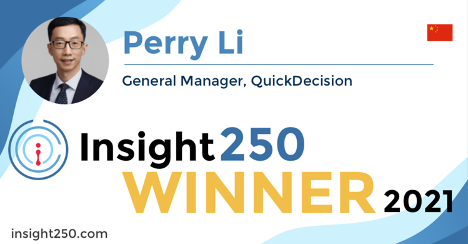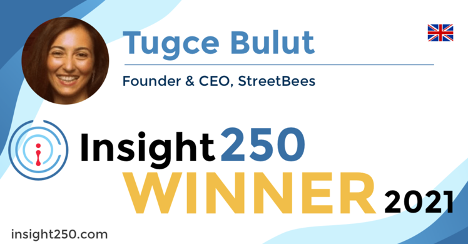



The Insight250 spotlights and celebrates 250 of the world’s premier leaders and innovators in market research, consumer insights and data-driven marketing. The inaugural list was revealed this April and created renewed excitement across the industry whilst strengthening the connectivity of the market research community.
With so many exceptional professionals named to the Insight250 it seems fitting to tap into their expertise and unique perspectives across an array of topics. This weekly series focuses on doing just that; inquiring about the expert perspectives of many of these individuals in a series of short topical features.
This edition features three leading experts who are pushing the boundaries of artificial intelligence and leveraging its competitive advantages. Alex Hunt is the CEO of Behaviorally, Tugce Bulut is the Founder and CEO of StreetBees and Perry Li is the General Manager of QuickDecision.
As the complexity of data increases, innovative researchers are turning to the advantages of artificial intelligence (AI) in order to manage, integrate, analyse and extract insights to drive strategies, decisions and innovations. As the utility of AI advances the challenges are changing and concerns are growing as to how it will impact and shape the future of market research and data-driven understanding. These experts provide their front line perspectives on the state of AI and where it is headed.
Crispin: How are your businesses using artificial intelligence (AI) and what benefits are you seeing from it?
Perry: “My current company, QuickDecision, is heavily invested in AI to transform traditional market research into a more efficient and effective approach to help our clients better cope with the fast-changing business environment. China has one of the most competitive consumer goods markets and a successful brand needs to bring new products to market quickly, often in 3 to 6 months. So, we have over 60 engineers who work hard to turn the innovative research solution into a real tool. For example, we can easily find rural young cartoon fans who like sports, and ask them who their favorite key KOL (key opinion leader) is. Our most advanced ezTalk product helps clients interact with 500 consumers around China in order to observe their viewing behaviors on eCom in real time. This benefits clients in order to make fast, accurate business decisions.”
Tugce: “AI is critical to Streetbees’ methodology. We capture consumer insights through open text and AI is what enables us to take huge volumes of unstructured data and create deeply nuanced insights that help our clients uncover hidden growth opportunities. The combination of open text and AI takes us a step ahead because it essentially allows us to read between the lines and understand people’s motivations in a way they don’t directly articulate. For example, someone might tell us they had a rough day, then later tell us about a product they bought. They might not recognise that there’s a connection between those things, but AI can, which helps identify new markets for brands.”
Crispin: Alex, your business recently launched two AI-based solutions (Flash.AI™ and Flash.PDP™) what has the client response been and how are these solutions delivering growth to brands?
Alex: “Yes, Behaviorally launched Flash.AI™ and Flash.PDP™ in April and July respectively. Both products apply image recognition AI to respond to unmet needs in the shopper innovation process; in the former instance consumer-based screening of early packaging design ideas, in the latter an always-on monitor to identify where images on product detail pages (PDPs) are deficient in driving sales at digital shelf. Client response has been phenomenal. This is as much testament to the Behaviorally innovation process as it is to the application of AI, per se. We develop new solutions based on a rigorous customer feedback and advisory cycle and strategic alignment of efforts with Behaviorally’s core expertise in shopper. AI is deployed like any other technology if it gives us a material benefit and acts as an accelerant to address relevant customer needs, versus as an end unto itself. This ensures Behaviorally solutions address relevant gaps in the market to benefit clients’ growth objectives. In these instances AI being applied improves their success odds further down the pack development funnel, as well as drive growth in conversion at the digital shelf.”
Crispin: Perry, you were with Procter & Gamble for 20 years. How are they using AI and do you feel some countries are further ahead than others in applying AI within research? Do you see potential dangers with AI applications?
Perry: “In my personal opinion, P&G is leading the way in applying AI to drive business growth. They are really keen to explore the most innovative ideas and tools to think through how to drive practical business applications. They were just ranked No.1 ‘Most Innovative Client’ in the GRIT Report. I think different countries may be ahead in some areas, mostly linked with the overall business environment. For example, in China, many people have more advanced experience with eCom and Short Video (e.g. TikTok) related research via AI since the ecosystem is more developed, so we can test and iterate many new approaches around this.”
Crispin: Are there areas where the application of AI will create new markets and areas of investigation that were previously unimaginable or unmanageable for insight and analytics professionals?
Tugce: “Definitely! The ability to in effect “be there” as people make decisions or consume products is a huge step forward in really understanding human behaviour. AI then uncovers a level of emotion and nuance that I don’t think we, as insights professionals, have been able to tap into effectively in the past. Ultimately, it’s qualitative depth at a quantitative scale.”
Perry: “One example is QuickDecision is leveraging the AI capability of our brother company, Kuaizi, to automatically analyze short videos and code them by frame, together with the big data from TikTok. This allows us to understand exactly, by the second, how consumers view, skip and click a video and why they take these actions. It is an amazing tool that guides our client on short video development and increases its effectiveness.”
Alex: “Absolutely! Anywhere there are disparate and extensively large datasets, and time and scalability are at stake, AI will provide the necessary toolkit to attack previously unimaginable or unmanageable objectives. But it is the successful application of AI to real client challenges, rather than AI itself, that creates genuine innovation. Consumer insights or analytics solutions must be closely aligned with the commercial context in which they seek to add value. In the shopper domain, where Behaviorally is an indisputably market leader, growth in e-commerce and digital retail will continue to be exponential, presenting never ending challenges for brands to overcome. Manufacturers are struggling to define, diagnose and establish competitive advantages in this new channel that presents an unprecedented volume of content and compliance issues, most notably with images they have no tools to optimize. Through Flash.PDP, we provide AI-based consumer guidance at the speed, scale and interval the commercial context requires. It has enabled Behaviorally to not only develop true expertise in what drives choice at the digital shelf, but does so in a way that’s commercially useful to our clients.”
See part 2 here = https://archive.researchworld.com/insights-from-the-insight250-winners-the-role-of-artificial-intelligence-in-insight-innovation-part-2/


